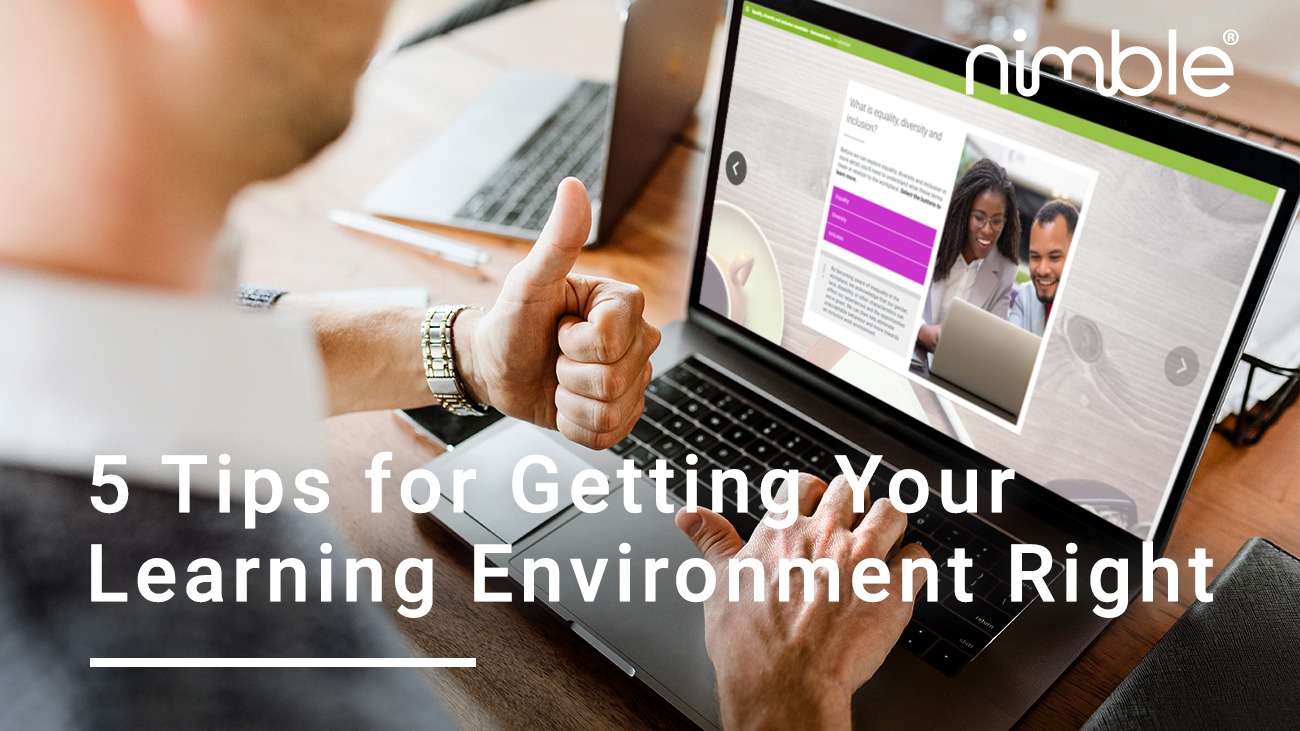Are you sitting comfortably and free from distractions? Then let’s begin.
Learning is a cognitive function that requires the brain to work in complex ways. To maximise that functionality, the brain needs a conducive environment in which to work. Due to the COVID-19 pandemic, more of us are working from home than ever before. The trend for remote working may continue after life returns to some normality, but that environment has its ups and downs for both the employee and the organisation.
No matter where we are located, getting the environment right for learning is key to absorbing information and retaining it, as well as helping to create a positive and happy workforce.
Here are 5 tips that can enhance the learning environment and improve learning outcomes in the process:
1. Start with your learning culture

Before we explore your learners’ physical environment, the first step is to make sure you have a robust learning culture in your organisation. Whether it’s for onboarding, products, services, personal and professional development or compliance training, your employees must know you value them enough to support and encourage them by allowing them adequate time and resources to learn and upskill.
You must be consistent, and ensure that this mindset is the same throughout each department in your organisation. If you ignore taking the time to create a healthy learning culture and working environment, it can instantly create negativity, resentment and poor motivation.
COVID-19 has added another emotional dimension for employees both on and returning from furlough. Long periods away from colleagues, and the loss of the day-to-day routine of working may exaggerate feelings of isolation, so it’s really important to provide support during these challenging times. Mental Health Awareness and Resilience training is a great place to start. In our article on what you need to know about training your employees on furlough, we offer further useful tips and advice.
Do you fully utilise the expertise across your organisation? A great way to support those who may be struggling is to call upon support systems and peer mentors in your workforce. A learning culture also must be democratic too, so there needs to be a way for learners to feedback to managers/learning designers. Consider using a survey as part of your elearning courses for ideas sharing. When learning is done ‘with’ them instead of ‘to’ them, people feel they are part of something bigger and what they are learning contributes to the bigger picture of ‘we’re all in this together’.
2. The learning environment itself

Where do your employees complete their online training on your premises? The physical space you provide for learning tells them how important the process is by what’s around them.
If they’re stuffed into small, dark, windowless rooms and given a rushed half-hour to do the course – they’re being told that learning isn’t valued. Consider putting them in a space that is pleasant and friendly without constant interference, then the message of value will be very different indeed.
What are the room conditions like? Loud and noisy? For some people, that distraction impedes learning (though not for all). Others find silence equally stressful. In a learning culture, these factors should be discussed with your learners and decisions can be taken to create the right environment for most people.
Whilst at their computer screens are your learners sat correctly? There are health and safety implications to consider here too. Can they access your online courses on multiple device types?
Ensuring your elearning tools provide responsiveness on different devices gives learners the flexibility and convenience to learn anywhere at any time – and that’s great. By keeping your audience engaged, you’ll achieve higher completion rates and better learning outcomes. A win-win for both you and your employees! Our authoring tool Nimble Author is fully responsive and allows you to view instantly how your courses will look on any device. To learn more about the benefits of responsive elearning, have a look at our article specifically on the subject of why responsive elearning is better.
Let’s bring in the added factor of remote working. Although it’s difficult for organisations to manage someone’s home environment and all the distractions that can bring, it’s good practice to check in with your learners prior to their training sessions to ensure they are in the right circumstances both mentally and physically to absorb the important knowledge you need to impart.
Have you enabled your learners to block out time in their calendars (during their working hours) where they can do the training undisturbed by telephone and video calls, meetings, and emails? From guidance on setting up your workspace, staying safe and secure, communicating remotely, and maintaining productivity while away from the office, our fully editable ‘Home working essentials‘ elearning course helps companies and employees understand the importance of making the most from working in a home environment.
3. Create an environment that’s interactive

Engage your learners by creating an interactive environment. It’s a fact that passive learners don’t learn as much as active learners, and knowledge gained from passive learning doesn’t remain in the long-term memory for long.
Unable to provide face-to-face training? Elearning is the nearest it gets to having the tutor there to work with you. What better environment is there than that? Active learning requires ‘interactivity’. There can be various exercise interactions built into elearning authoring software, but we’re talking beyond that. Here are some ideas:
- Stimulate the learner with video or audio files – not just to be watched or listened to, but followed up with questions to test what has been understood
- Consider consolidation and reflective exercises to increase engagement and improve workplace transfer
- Add hyperlinks to websites to provide further investigation/reading – also include open questions to add relevancy
- Embed PDFs or documents linked to the course which provide further useful information
- Include details about resources that offer advice and support – this reinforces a healthy learning culture
- Relevant visuals are important. Use pictures and illustrations that amuse – don’t forget, humour is a form of interactivity!
- Include ideas for collaborative exercises with others in the team at the end of the elearning course – ideally with others taking the same course
- Add a survey or questionnaire to provide the facility for idea sharing and feedback – this will make the learner feel their input is valued
To find out more about making elearning more engaging, we’ve shared our 7 tips on how to make elearning visually engaging here.
4. Clarity is key

How well you convey knowledge is as important as what your learners will do with it. There is a danger in all learning resources that while the author understands it, the learner might not, so clarity of content and context is key. Confusion at this stage will not be conducive for the learner to relax and comprehend what they will be undertaking.
Fostering a good learning environment is also about the why. For the learner, “Why am I doing this training – what’s in it for me?”. For the trainer, “Why do I need them to do this training – what are the objectives and what do I need them to learn?”. You have to ask of the training itself – How worthwhile is it for my learners? Will the knowledge be retained? Does it serve a broader purpose? Is the learning sustainable? Here are a few other things to consider:
- Have you included and clearly laid out the objectives and topics in your course?
- Is the length of the course just right? Are you giving them enough time to complete it? Have you considered the physical learning environment?
- Does the course need a jargon buster to give greater access? Are questions and instructions easy to understand?
- Does the course flow naturally from one page to the next? By flow, we mean, does the learning naturally lead into the next activity? Is it obvious how it achieves the learning objective all the time?
- Are you considering your audience? Is the vocabulary pitched at the right level? Is it relevant to them and their role?
- Did you consider potential disabilities or special needs of learners – and do you know what needs exist in your organisation?
5. Provide positive reinforcement

Motivation. It’s what drives us to do the things we do. And in the context of a learning environment, it’s no surprise that we work better when we’re motivated. A kind word at the end of a course helps, but that’s unlikely to motivate. Praise is a big part of it, but we’re talking about more than a pat on the back here. Praise comes in different forms:
Reward – what advantages are available for successful completion of a course? Does it provide the learner with certification? Will it help them accelerate their career path? Are they celebrated anywhere? Are significant successes highlighted by the people that matter?
Learning to learn – not all learners will have had a successful time in school/further education. People can bring their own personal baggage with them into learning environments, so get to know who might have difficulty, lack motivation or self-esteem. Support them. Help them ‘learn to learn’. They will be sensitive, so develop subtle approaches (peer mentoring perhaps?).
You’ll be surprised how many of us don’t know how to learn. That can lead to frustration and a ‘switching off’ in the brain to be open to the process. Creating a ‘learning to learn’ elearning course could be a great way to unlock some approaches and techniques for your learners to explore. There are lots of resources available on the subject that are worth further investigation.
Support systems – how are people informed that they need to complete courses in your organisation? Via formal, impersonal emails? Instantly, you’re turning people off that way. Make the emails more personal. Including a snippet about their success from a previous course is a great way to let them know their achievements are important to your organisation.
Explain why the course is essential to the learner (and the organisation too). Then, send a personalised reminder. After completion, send another email thanking them for their work and their successful result. Encourage them to contact you with their requests for further courses and training they may be interested in. Remember, it should be a two way street between learner and trainer and not just a tick box exercise!
To summarise, learning is a complex cognitive function. It’s rendered so complicatedly because there are other aspects of the brain that want to make contributions, so it’s important to get your learning environment right. Getting as many of these factors ‘right’ for learners will improve their learning experience – and hopefully the learning outcomes that follow.
If you would like to try out some of these tips in an easy-to-use and fully responsive authoring tool, then try out our authoring tool Nimble Author.


0 Comments